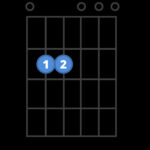Power chords are the backbone of countless iconic guitar riffs that resonate across genres. From the raw energy of “Iron Man” by Black Sabbath to the anthemic drive of “Hit Me With Your Best Shot” by Pat Benatar, and the grunge spirit of “Smells Like Teen Spirit” by Nirvana, power chords deliver a powerful and direct sound. But what exactly defines a power chord, and how can you unlock its potential on the guitar?
Essentially, a power chord is a simple yet potent chord consisting of just two distinct notes. The term “5” is used in chord notation (like C5, G5, etc.) because it’s built using the 1st (root) and 5th notes from a major scale. You’ll often see power chords written with the number 5 beside the root note, like this:
To understand how power chords are formed, let’s take the C major scale as an example. The C major scale provides the notes we need to construct a C5 power chord. The notes in a C5 power chord are the 1st (root) and 5th notes of this scale:
Importantly, the octave of these notes also works within the power chord. Whether you play a C or a G note in a higher or lower octave on the guitar, it will still be recognized as part of a C5 chord. This flexibility in voicing makes power chords incredibly versatile on the guitar.
To discover the notes for any power chord, you’ll need to identify the notes within its corresponding major scale. For instance, to find the notes that make up a G5 power chord, you would refer to the G major scale. The beauty of power chords lies in their formulaic nature – the name itself reveals how to construct and play it! The root note combined with the fifth creates that signature powerful sound.
Power chords are favored across rock, metal, punk, and many other genres due to their simplicity and raw energy. They are easy to play, making them a great starting point for beginner guitarists, yet they are also a fundamental tool for experienced players to create impactful riffs and rhythms.
Ready to learn how to play a power chord? Check out this video lesson from Fender Play and explore more guitar chord lessons by clicking here for a free trial.
Want to expand your chord knowledge? Explore Fender Play’s extensive chord library to learn various chord types and master essential guitar techniques.

